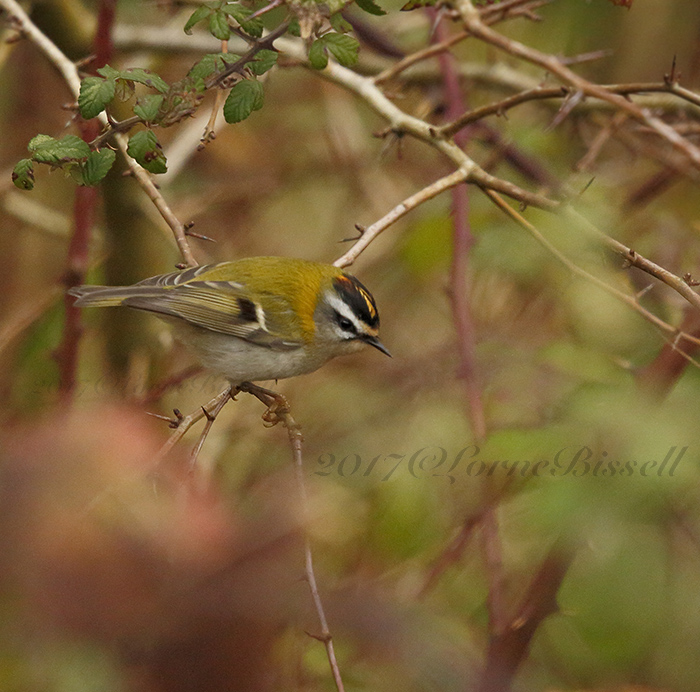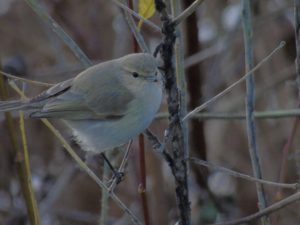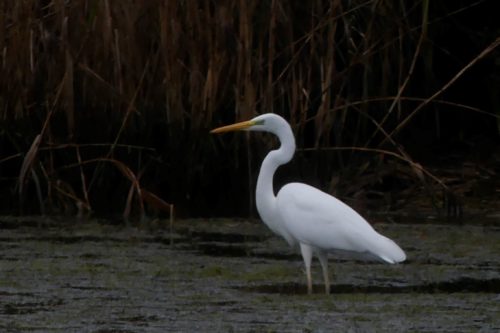THE YEAR 2017 in review at Longham Lakes, Dorset
This year has been fantastic in just about every aspect for this site, for birding and wildlife-watching generally. The total of 134 species of birds is a record, just, but it was the quality that stood out, and a nice touch was that unusual species often came at the same time. Six bird species appeared for the first time: Bonaparte’s Gull (26th April), Red-rumped Swallow (27th April), Serin (29th April), Common Scoter (7th October), Velvet Scoter (16th October) and Lesser Scaup (23rd October) bringing the overall total to 186 species. Several made their second appearance, namely Grasshopper Warbler (27th April), Bar-tailed Godwit (13th May), Grey Phalarope (12th September), Little Stint (15th September) and Black Redstart (31st October), while Hawfinch (21st October) turned up for the 3rd time. Other good birds included Great Egrets, with 3 at the beginning of the year and 1 at the end, Bearded Reedling, Yellow-browed Warbler, Arctic Tern, Water Pipit, Firecrest, Coal Tit, Osprey, Merlin, Black Tern, Garganey, Whinchat and many others. Other eclectic bird highlights included gatherings of 1000+ Starlings, a Chiffchaff ringed here after a trip 770km down from Scotland, a summer when over 200 Tufted Duckings hatched, and superb numbers of ducks and other waterbirds present in the autumn.
Among other wildlife, 2017 will stand out as an exceptional year for dragonflies and damselflies. This included 2 new species for the site, which were Red-veined Darter and Britain’s 8th Scarlet Darter. In early July these two, plus Lesser Emperor and Small Red-eyed Damselfly, were all present, allowing an unprecedented spectacle of 4 rare or scarce species on this single site. On 9th July no less than 16 dragonfly species were present on one square kilometre. This could constitute the highest number recorded at a single location on one day ever in Britain. At the same time there were 16 species of butterflies on site, although no rarities among these.
It was not spectacular for mammals in 2017, but there were at least 5 records of Otters, plus a Mink and a Stoat, and at least 6 species of bat, including Nathusius’s Pipistrelle.
This year, perhaps not surprisingly, saw a sharp increase in the number of birdwatchers visiting Longham, and there are now almost 200 pass-holders that use the car park. As a visitor and regular, I have been really pleased to see how the dog-walking visitors have almost invariably kept their pets under control. Unfortunately, the kayakers in the DUCKS group have regularly been seen violating their exclusion zones, particularly around the island in North Lake.
I will give the last word to Martin Wood who, along with Lorne Bissell, has visited Longham more often than any other birder this year, taking up the Patchwork Challenge, as did Darran Jones (https://greatbritishbirdhunt.blogspot.co.uk/).
“It has been a great year patching Longham with a list of 112 species seen with some wonderful lifers and site firsts for me, and it has been a pleasure and good fun sharing these birds with other Longham Birders and others. As I reflect on the past year some of the best moments were seeing my first Bonaparte’s Gull, which led to an exciting hour or so watching the Bonaparte’s with Terry Elborn and a Mike Gibbons, only for a Red-rumped Swallow to arrive, another first for me. Then on another day seeing Bearded Reedlings and the Lesser Scaup on the same day. And of course I cannot forget that magic moment when my picture of a dragonfly, which I assumed was a Red-veined Darter, was re-identified as a Scarlet Darter.
“There is something I have learned on this journey, and that is I need to learn more about how to identify bird calls during visible migration, as this is one part of my birding that lets me down . Also get to grips with the Dragonflies, more Butterflies and one new hobby I started this year, Moth-trapping (thanks to Mark Andrews.)”
A very Happy New Year to everybody. Bring it on!
31st December
The Great Egret is present, topping and tailing the year (Ian Lewis).
30th December
There were 2 Great White Egrets this morning – 1 on the Island in the South Lake and a 2nd bird which flew up from the River Stour and headed SW towards Poole Harbour. Otherwise still large numbers of birds on the South Lake including 17+ Pintail which is an exceptional count for the site. Also of note were at least 20+ Snipe flushed from the middle of the Island by a passing raptor and c1000 Starlings feeding in Hampreston Meadows (George Green.) Also 26 Greylag Geese, 171 Canada Geese (easily a record), 117 Lapwing, 13 Moorhen (also a record!), 1 Kestrel and 2 singing Song Thrushes (Trevor Thorpe).
29th December
Martin Wood writes: “Possibly my last walk round South Lake today as the New Year is starting to close in. A rainbow greeted me this afternoon as I pulled in to the car park and I wished for one new bird for the list. I scanned the island from the slipway just as it started to rain and sheltering from the wind a much as was possible were 10 Little Egrets, a Grey Heron and the Great White Egret (hopefully it will stick around for the New Year!) Most of if not all of the weed has now been blown on to the shore line, the Hampreston fields were flooded with most of the gulls and Canada Geese were in the far field on the other side of the river. While a few Teal and Wigeon were on this side of the river in the flooded field, a large number were still out on the lake with the best count of Pochard I have had this winter with 30 birds seen, still lots of other wildfowl about like Shoveler, Wigeon, Gadwall , Little Grebes 14, and Mute Swans 60. It was very nice to see the male Kestrel again with a small mammal which I was pleased to see that he is still hunting successfully and surviving this weather.
“Alas, my wish never came true as I could only locate two Snipe on the large island and neither of them a Jack snipe, which is one of the two birds I have been hoping to see, the other was a Water Pipit before the end of the year” (Martin Wood.)
27th December
There was a Goosander briefly on the North Lake today (Lorne Bissell).
26th December
Had a wonderful morning’s walk round south lake until the rain started. Still plenty of wildfowl about a good. Finally ticked off Treecreeper with two seen on the Oak Tree close to the to the fence in Samuel’s Wood. The Treecreeper is possibly the last new bird I will see at Longham in 2017. It as been a great year at the lakes- 113 birds for the Patch Work Challenge List, though for the Longham list this works out as 112 species plus 1 Siberian Chiffchaff (Martin Wood.)
24th December
Great White Egret still present – seen flying along River Stour and then across South Lake (George Green.) Plenty of other birds about; the lakes are thick with them. A Mediterranean Gull was a decent bird (Dominic Couzens, Ed Parnell).
23rd December
Still lots of wildfowl out on the water. Looked through c200 Black-headed Gulls hoping to find a Bonaparte’s but only 1 Mediterranean Gull among them, plus a couple of Common Gulls. 40 odd Lapwing were circling round the Island (Martin Wood.)

Firecrest, Longham Lakes, Dorset 21/12/2017 (Lorbe Bissell)
21st December
2 Firecrests were present today (Lorne Bissell).
20th December
Great White Egret still on South Lake this afternoon, plus Black-tailed Godwit (George Green.)
18th December
I did a rough count and estimated at least 1700-2000 birds were on the South Lake. These are by far the highest numbers since I started regularly visiting Longham Lakes in 2011. Today’s highlights have included Pintail and Black-tailed Godwits (George Green.)

Putative Siberian Chiffchaff, Longahm Lakes, Dorset 16/12/2017 (Martin Wood)
16th December
I had brief views of what was presumably a Siberian type Chiffchaff. Also Pintail and Black-tailed Godwit (George Green.) Another good walk round South Lake this afternoon, with 42 species seen. The highlight for me was seeing a site 1st for me, a wonderful Firecrest. A mass of wildfowl are still out on the lakes with c50 Teal, 2 Pintail, 20 Pochard and loads of Wigeon, Gadwall and Coot. The Great White Egret was on the large island again this afternoon with 5 Snipe with 8 Little Egrets at one time. And I found another Bullfinch today (Martin Wood.)
14th December
Stacks of birds – about c200 Wigeon, Lapwing 100, Gadwall c100, Pochard 25, Meadow Pipit c40 but could not find a Water Pipit among them, they were on the flooded field west of the lakes. The highlight of the day though was seeming a Great White Egret on the large island in South Lake and 4 male Pintails close to the western shore . Mission Bullfinch was also completed[finally!] with 2 Bullfinch seen near the visitor centre (Martin Wood.)

Great Egret, Longham Lakes, Dorset 13/12/2017 (Trevor Wilkinson)
13th December
The South Lake was very busy, and with more ducks on the North Lake than I’ve seen for a while. Counts included 1 Great White Egret, Little Egret, 3 Moorhen, 3 Little Grebe, 10+ Goldfinch, 6 Fieldfares, 5 Lapwing, 1 Greylag Goose and 70 Canada Geese (Trevor Wilkinson.) On the same day, Dave and Pat Harris saw some extra stuff, including Grey Wagtail, Chiffchaff, Pintail, Black-tailed Godwit and Water Rail (heard.)
3rd December
There was a nice male Kestrel on a fence, consuming a small mammal. Still c100 Lapwing resting on the mat of weed close to the western shore. Plenty of Redwing and Fieldfare about, and a Goldcrest. A Water Rail was showing well by the jetty in the north east corner (Martin Wood.)
1st December
A very nice, icy-cold walk round South Lake, revealing a good number of Wigeon and Gadwall, plus at least 10 Pochard along with 8-9 Teal. A Kingfisher was on the west bank, perched on a low branch over the ditch. A Sparrowhawk came over the south end of Samuel’s Wood and flew across the little pools towards Emily’s Wood. Great to see 24 Fieldfare and Redwing feeding on berries in the scrub area on the east side . Also it was wonderful to be able to get close to two Water Rail feeding out in the open in the north-east corner of south lake just by the jetty (Martin Wood.)
